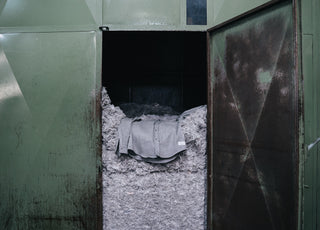With my headphones on, I lean into my laptop, and press play on an audio clip sent to me from Italy. I hear the low baritone voice of a man introducing himself. “Hi everybody,” he says brightly, “I am Stefano, and I am a technician specializing in carded fabrics.” Stefano’s Italian accent shines through his superb English—I smile, immediately charmed.
Stefano is responsible for creating the one-of-a-kind colourways of our recycled wool. He studied in Italy to become a Textile Technician, then began his career in Prato, Italy, the beating heart of the Italian recycled textiles industry. Prato is a city with a long history of recycling textiles spanning back hundreds of years. To say that they are masters of their craft would be an understatement. As I listen to Stefano explain his process, it is clear that this is more than a job—it’s an art form.


As with anything recycled, we begin with something old to create something new. In this case, it is piles and piles of discarded wool sweaters. Stefano’s co-workers sit amongst the mountains of old sweaters meticulously organizing them by colour, flinging pieces this way and that in a woollen tornado. The sweaters are then shredded into small pieces by a machine containing rows of machete-like blades. The handfuls of shredded wool are then washed in gigantic washing machines that make the household machine I grew up with look like a toy. What’s left are large amounts of clean woollen fluff in various colours.

Stefano references a photo of what, to me, looks like seemingly random piles of this coloured woollen fluff: “…you can see that I am stacking different materials and colours to obtain a good uniform final colour.” I raise my eyebrows at this simple explanation. The photo doesn’t illustrate that he has measured each bit of coloured wool, and intentionally taken more of one colour than the other. Then he has added a handful of yet another colour to get it just right. Drawing upon his years of experience and instincts, Stefano can create—by eye—a desired colour, whether it’s ruby red, deep ochre, or midnight blue.

Much like when brewers make a new beer, rather than just going for it—which could result in a large amount of undesired product—a small “test batch” is made. The same approach is taken here to make sure the colour is just right. Stefano’s calculated collection of woolly bits is fed into a carding machine. Carding is an ancient process that disentangles, cleans, and intermixes fibres to produce a continuous fibrous web. It is just one step in creating a usable yarn. In its early years, carding was done by hand using the vibrations from a unique bow contraption, and then later using two handheld paddles with tiny metal teeth. In other words, some serious elbow grease. Stefano has shared photos of their carding machine in Prato, which is made up of a network of enormous rollers, some small and some large, some spinning very fast, and others quite slow. Each roller is covered in tiny metal teeth that work against each other to pull apart and combine the fibres. It’s essentially an aggressive and lengthy rollercoaster ride for the wool.

In the test batch, the carding process creates a small, fleecy sheet of web-like fibres that has now taken on a visibly uniform colour. Still listening intently to the audio clips, I hear Stefano inform me that, “…the material is ready for the spinning process when we will obtain the coloured yarn.” The fleecy material is spun into yarn and then woven into a wool fabric. If Stefano is happy with the result, he works his magic to recreate it on an industrial scale. As I reach the final audio clip, Stefano reminds me that each colour he creates is unique. As the feed stock—the old sweaters—varies so much, it can be tricky, if not impossible, to repeat a colour exactly. This is what makes each colourway one-of-a-kind.

At Anián, we often have folks marvel at the fact that there are no dyes used in our recycled wool and recycled cotton garments. When the process is explained, there’s always a wide-eyed nod of amazement because, as you just learned, it’s no small feat.
In the world of recycled natural fibre textiles, new dyes are entirely unnecessary. While it is indeed a laborious process, Stefano’s work is worth it from many angles: craftsmanship, history, and quality that is inherently environmentally conscious. Buying recycled natural fibre clothing whenever you can helps to support the slow and circular fashion movements, and incrementally helps change the fashion industry.




